Repeatability, Reproducibility and Standardisation of a Laser Doppler Imaging Technique for the Evaluation of Normal Mouse Hindlimb Perfusion
Abstract
:Background
Methods
Results
Conclusions
1. Introduction
2. Experimental Section
2.1. Materials and Methods
2.1.1. Animal Studies
2.1.2. Repeatability and Reproducibility
2.1.3. Standardisation of LDPI
- Hair of the hind limbs removed with a clipper (ARC) versus hair removed with an apposite depilatory cream (ARD);
- dorsal versus ventral decubitus position;
- inhalation anaesthesia performed using isoflurane (4% induction dose, 2.0% maintenance dose) plus oxygen (1 L/min). Subsequently, mice were placed in the selected decubitus position;
- injectable anaesthesia. A combination of 100 mg/kg of ketamine plus 10 mg/kg of xylazine was injected intraperitoneally. After LDPI acquisition, 1 mg/kg atipamezole was injected into the mice for anaesthetic reversal;
- The desired body temperature (36 °C versus 38 °C) was achieved through the use of a thermo-heated carpet and an infrared lamp. Temperature was monitored with an endorectal probe.
2.1.4. Laser Doppler Perfusion Imaging
2.1.5. Statistical Analysis
3. Results and Discussion
3.1. Repeatability and Reproducibility
3.2. Standardisation
- the mode of depilation in mice anaesthetised with isoflurane at 36 °C or 38 °C. The ARD mice presented perfusion values higher than those of ARC mice (Figure 3).
- the body temperature in mice anaesthetised with isoflurane, whether depilated via ARC or ARD. A mouse body temperature of 38 °C yields higher perfusion values. (Figure 3).
- ARC-depilated mice anaesthetised by injection and with a 36 °C body temperature have higher values. In contrast, mice anaesthetised with isoflurane, with fur and with 38 °C body temperature have higher values (Figure 8).
- The body temperature in mice anaesthetised with isoflurane, in ARC and ARD mice. There is a significant difference in perfusion values by body temperature in ARC-depilated mice anaesthetised by injection. The perfusion values in mice with a body temperature of 38 °C are always higher (Figure 9).
4. Discussion
5. Conclusions/Outlook
Acknowledgments
References
- Paigen, K. Understanding the human condition: Experimental strategies in mammalian genetics. ILAR J. 2002, 3, 123–135. [Google Scholar]
- Condeelis, J.; Weissleder, R. In vivo imaging in cancer. Cold Spring Harb. Perspect. Biol. 2010. [Google Scholar] [CrossRef]
- Massoud, T.F.; Gambhir, S.S. Molecular imaging in living subjects: Seeing fundamental biological processes in a new light. Genes Dev. 2003, 5, 545–580. [Google Scholar]
- Sarnik, S.; Hofirek, I.; Sochor, O. Laser Doppler fluxmetry. Biomed. Pap. Med. Fac. Univ. Palacky Olomouc Czech Repub. 2007, 1, 143–146. [Google Scholar]
- Laser Doppler Flowmetry-A Theoretical Framework. Available online: http://www.imt.liu.se/bit/ldf/ldfmain.html (accessed on 20 December 2012).
- Key, H.; Jackson, P.C.; Wells, P.N. New approaches to transillumination imaging. J. Biomed. Eng. 1988, 2, 113–118. [Google Scholar]
- Humeau, A.; Steenbergen, W.; Nilsson, H.; Strömberg, T. Laser Doppler perfusion monitoring and imaging: Novel approaches. Med. Biol. Eng. Comput. 2007, 5, 421–435. [Google Scholar]
- Niiyama, H.; Huang, N.F.; Rollins, M.D.; Cooke, J.P. Murine model of hindlimb ischemia. J. Vis. Exp. 2009. [Google Scholar] [CrossRef]
- Rayssac, A.; Neveu, C.; Pucelle, M.; van den Berghe, L.; Prado-Lourenco, L.; Arnal, J.F.; Chaufour, X.; Prats, A.C. IRES-based vector coexpressing FGF2 and Cyr61 provides synergistic and safe therapeutics of lower limb ischemia. Mol. Ther. 2009, 12, 2010–2019. [Google Scholar]
- Cho, W.G.; Albuquerque, R.J.; Kleinman, M.E.; Tarallo, V.; Greco, A.; Nozaki, M.; Green, M.G.; Baffi, J.Z.; Ambati, B.K.; De Falco, M.; et al. Small interfering RNA-induced TLR3 activation inhibits blood and lymphatic vessel growth. PNAS 2009, 17, 7137–7142. [Google Scholar]
- Kragh, M.; Quistorff, B.; Kristjansen, P.E.G. Quantitative estimates of angiogenic and anti-angiogenic activity by laser Doppler flowmetry (LDF) and near infra-red spectroscopy (NIRS). Eur. J. Cancer 2001, 37, 924–929. [Google Scholar]
- Committee for the Update of the Guide for the Care and Use of Laboratory Animals; National Research Council. In Guide for the Care and Use of Laboratory Animals, 8th ed.; The National Academies Press: Washington, DC, USA, 2011.
- Bland, J.M.; Altman, D.G. Statistical methods for assessing agreement between two methods of clinical measurement. Lancet 1986, 327, 307–310. [Google Scholar]
- Yang, X.P.; Liu, Y.H.; Rhaleb, N.E.; Kurihara, N.; Kim, H.E.; Carrettero, O. Echocardiographic assessment of cardiac function in conscious and anesthetized mice. Am. J. Physiol. Heart Circ. Physiol. 1999, 277, H1967–H1974. [Google Scholar]
- Constantinides, C.; Mean, R.; Janssen, B.J. Effects of isoflurane anesthesia on the cardiovascular function of the C57BL/6 mouse. ILAR J. 2011, 52, 21–31. [Google Scholar]
- Gargiulo, S.; Greco, A.; Gramanzini, M.; Esposito, S.; Affuso, A.; Brunetti, A.; Vesce, G. Mice anesthesia, analgesia, and care, part II: Special considerations for preclinical imaging studies. ILAR J. 2012. Available online: http://nas-sites.org/ilarjournal/current-issue/neurobiology-of-addictive-behaviors/mice-anesthesia-analgesia-and-care-part-ii-special-considerations-for-preclinical-imaging-studies/ (accessed on 27 December 2012).
- Yang, X.P.; Liu, Y.H.; Rhaleb, N.E.; Kurihara, N.; Kim, H.E.; Carrettero, O. Echocardiographic assessment of cardiac function in conscious and anesthetized mice. Am. J. Physiol. Heart Circ. Physiol. 1999, 277, 1967–1974. [Google Scholar]
- Michauld, S.E.; Menard, C.; Guy, L.G.; Gennaro, G.; Rivard, A. Inhibition of hypoxia-induced angiogenesis by cigarette smoke exposure: Impairment of the HIF-1alpha/VEGF pathway. FASEB J. 2003, 10, 1096. [Google Scholar]
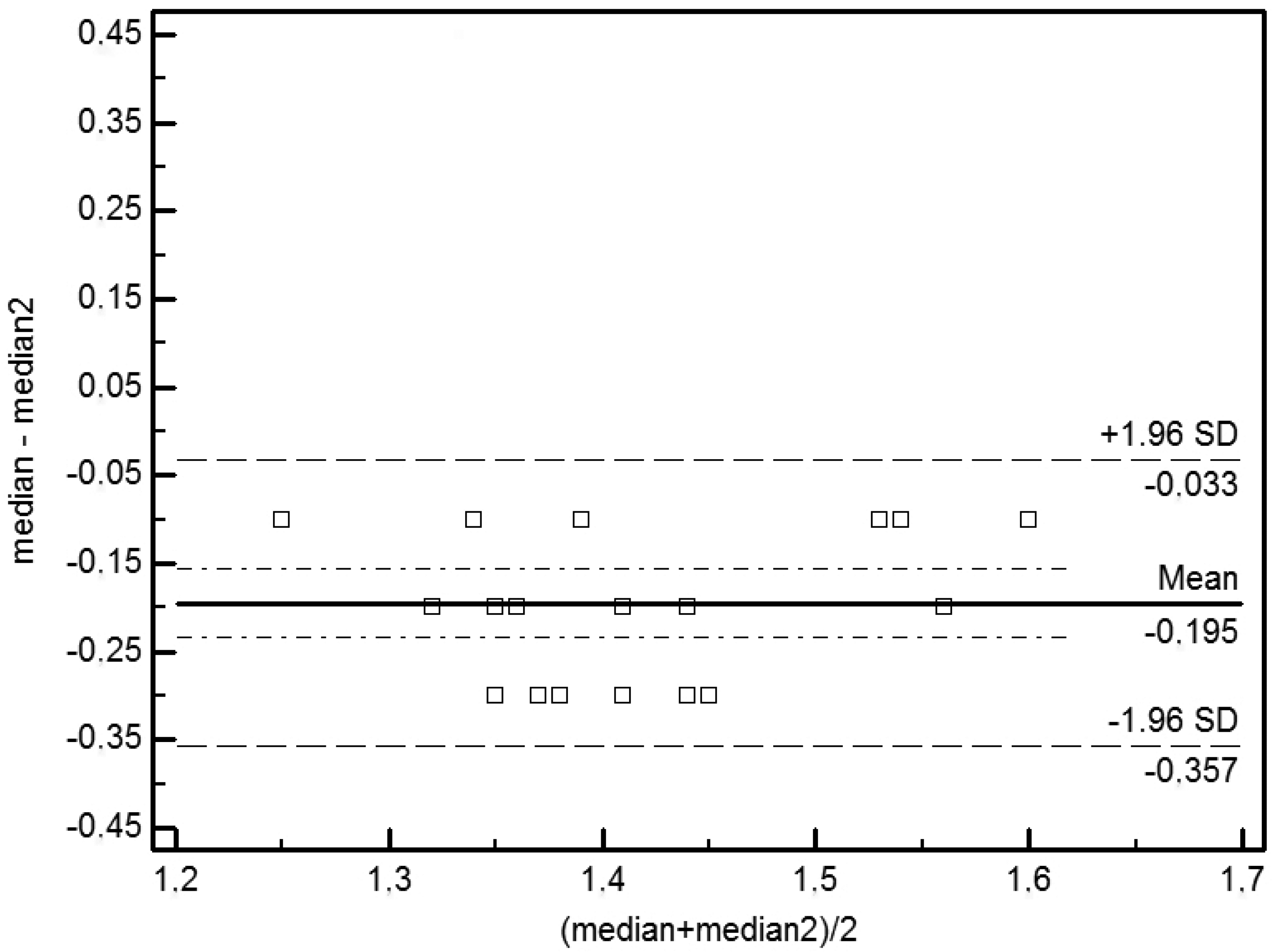
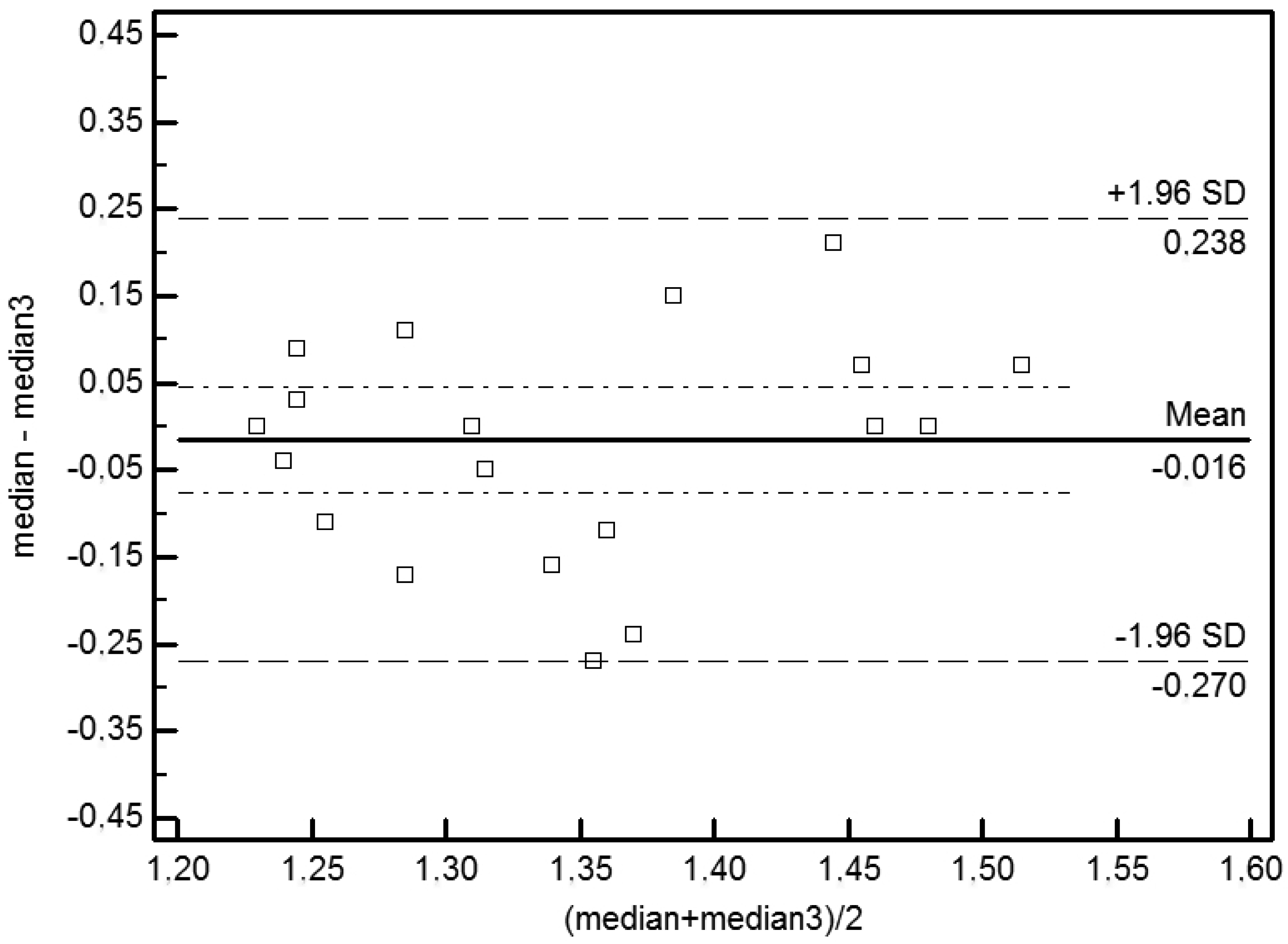
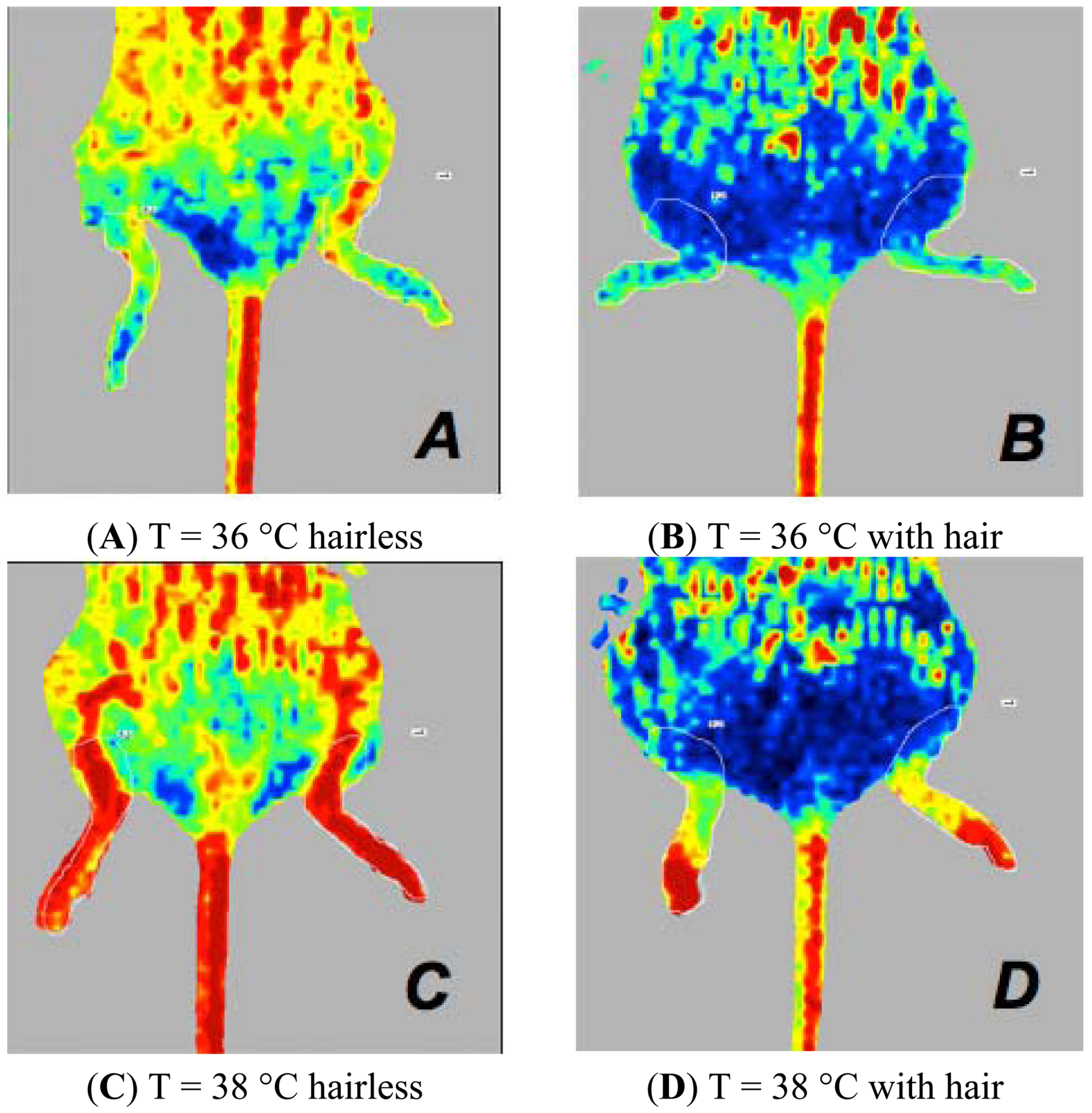
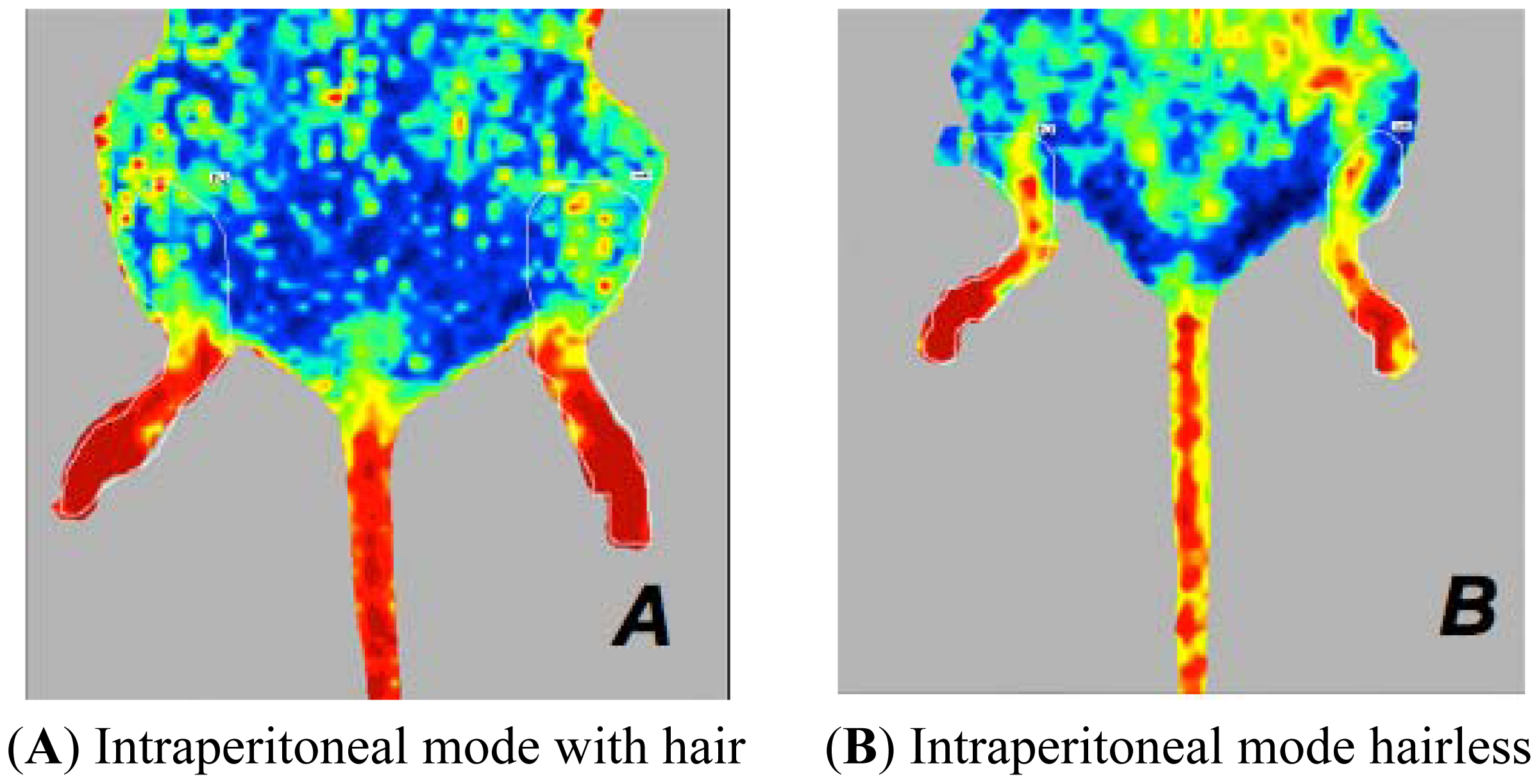
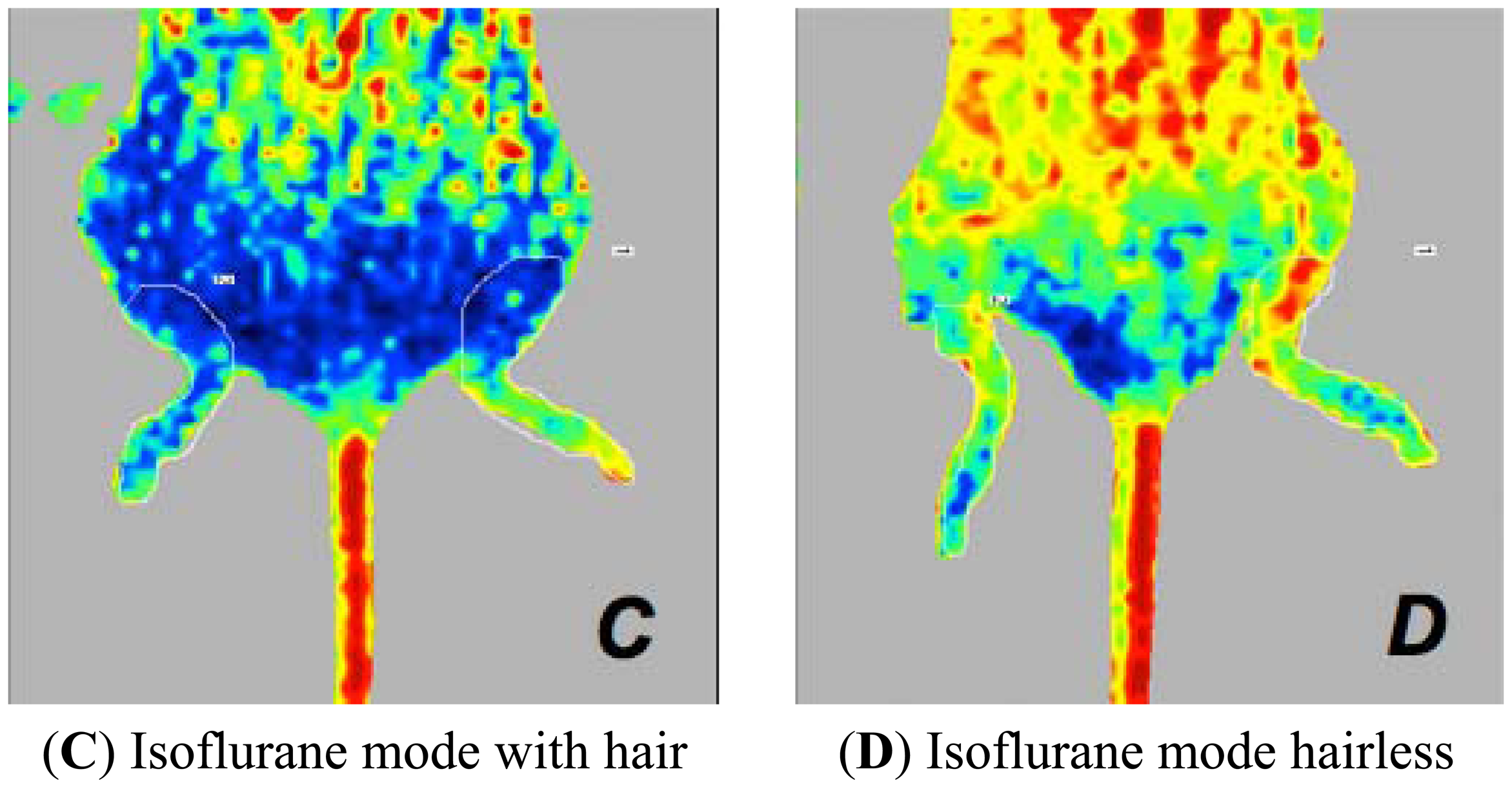

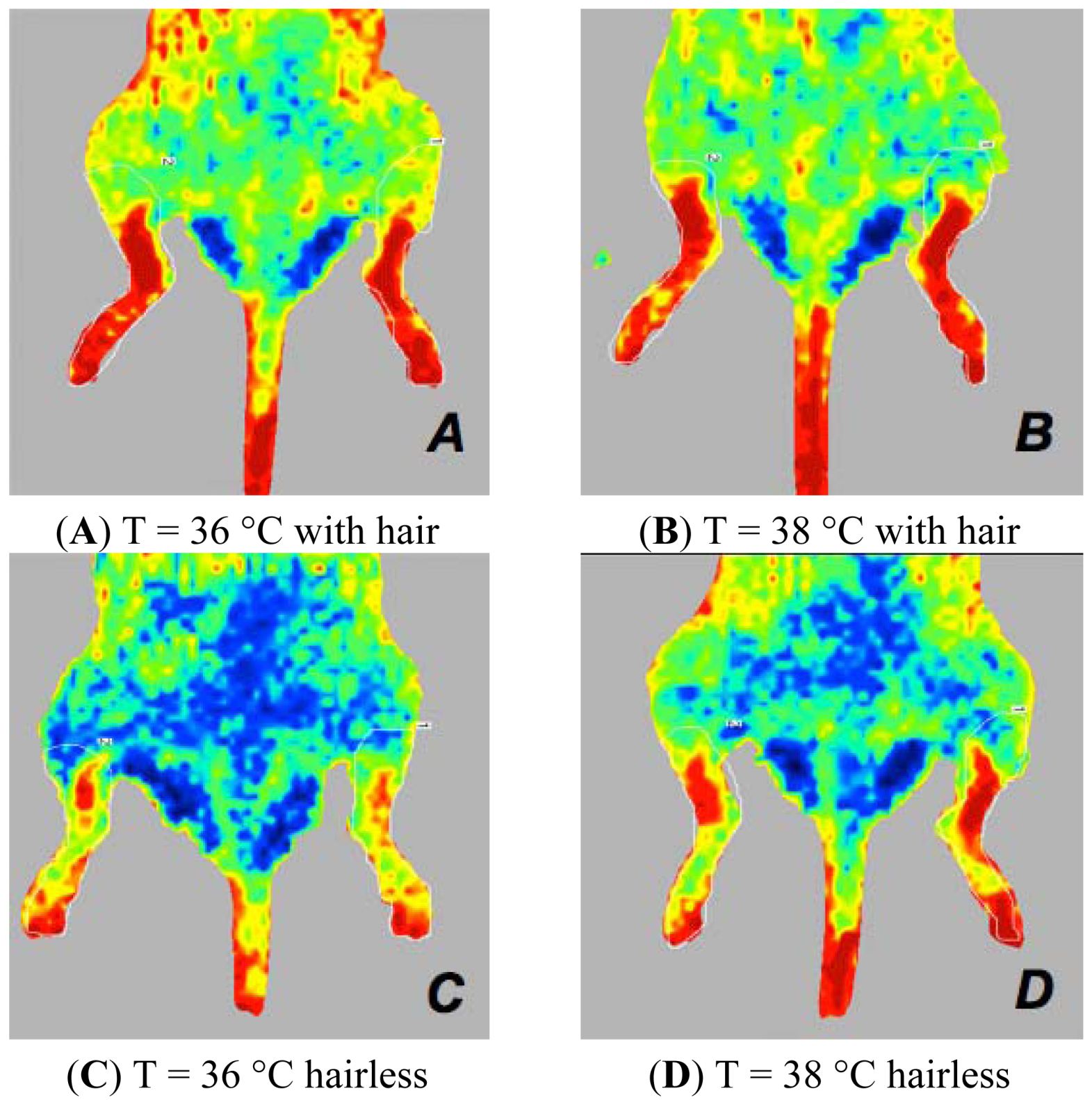

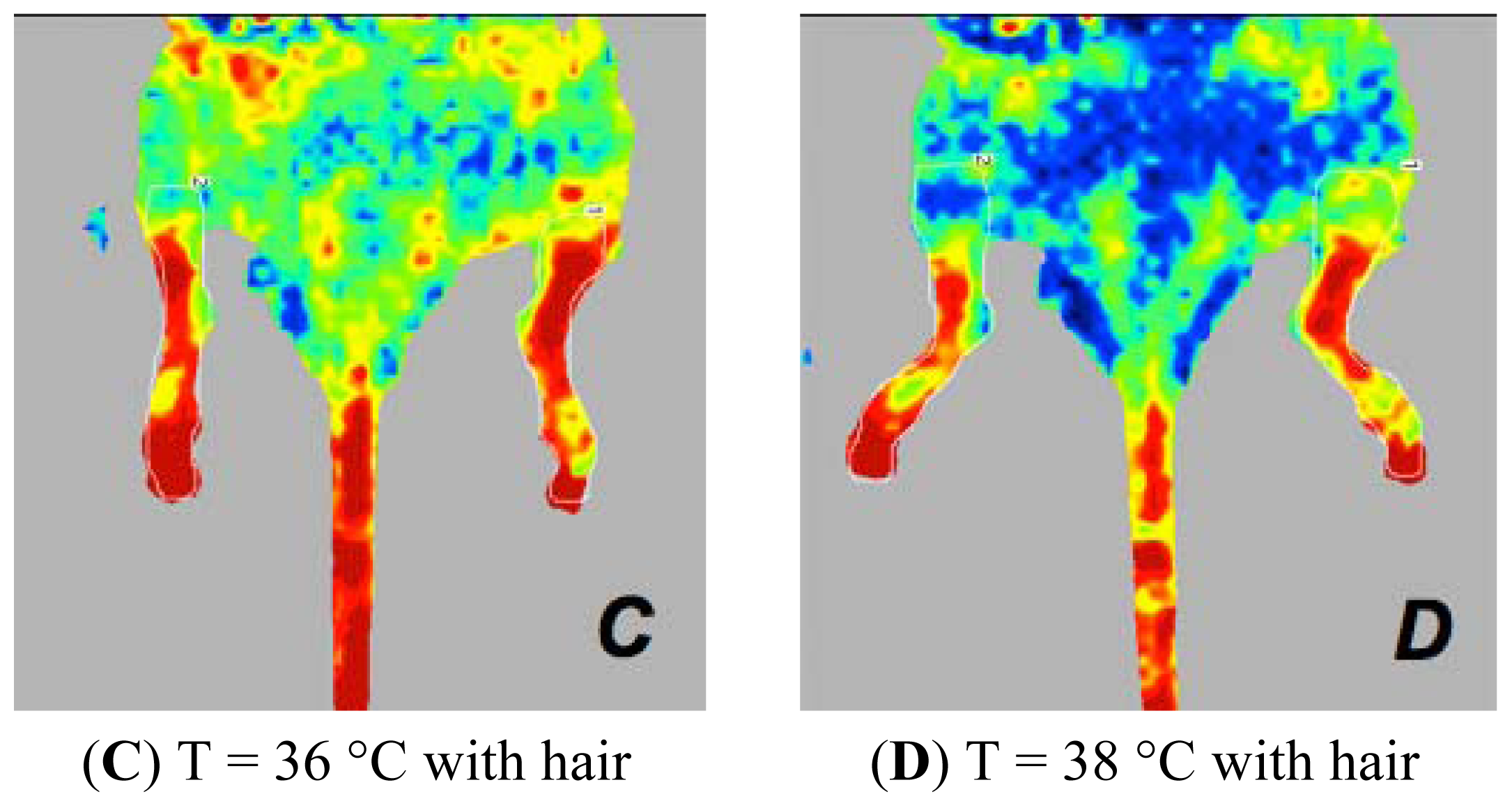
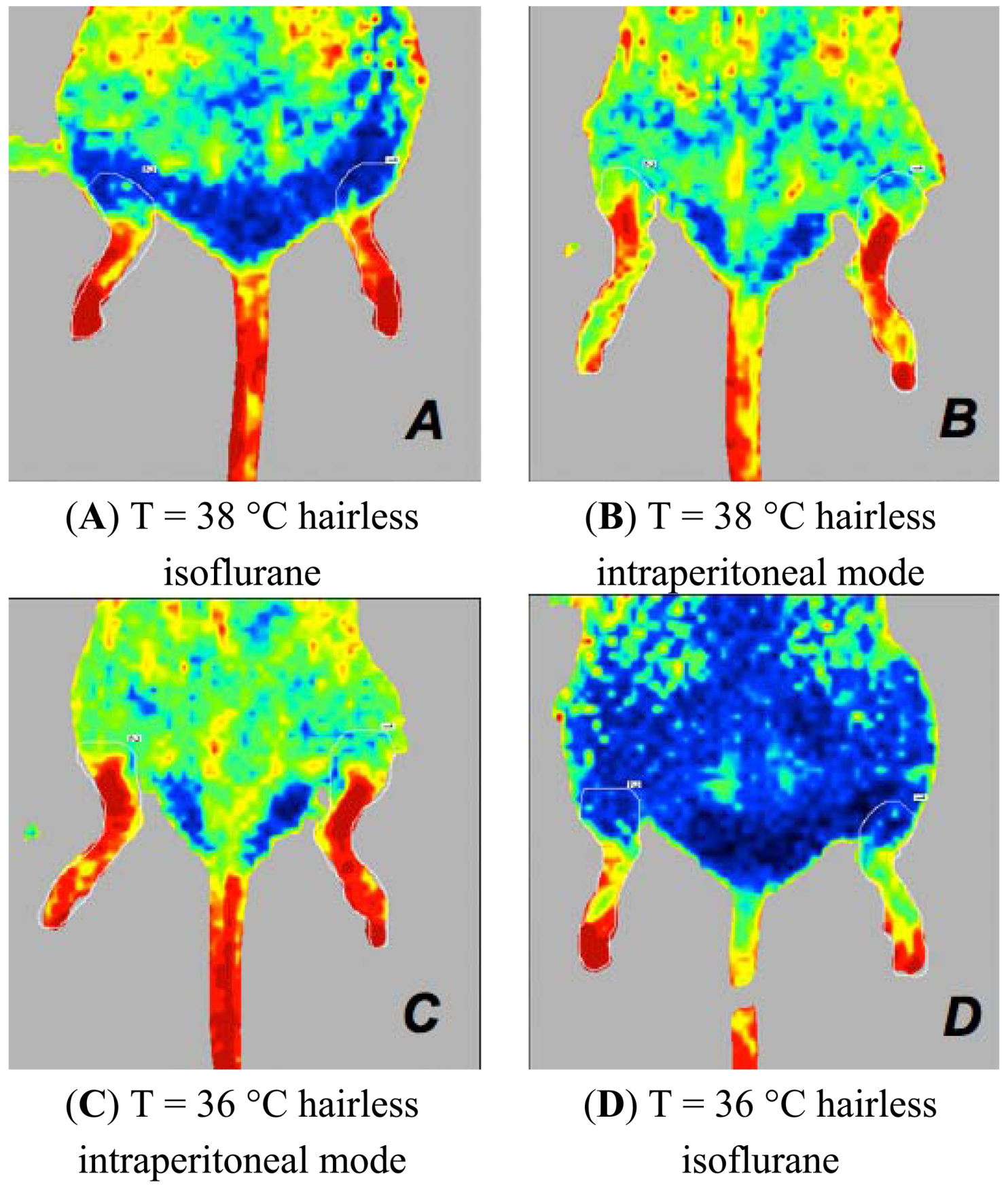

| Hair | Anaesthesia | Value | Temperature | |||||
|---|---|---|---|---|---|---|---|---|
| 36 °C | 38 °C | |||||||
| 25th Percentile | Median | 75th Percentile | 25th Percentile | Median | 75th Percentile | |||
| ARD | inhalational | Min | 0.69 | 0.73 | 0.79 | 0.72 | 0.80 | 0.87 |
| Median | 1.64 | 1.77 | 1.91 | 1.88 | 2.08 | 2.25 | ||
| Mean | 1.78 | 1.92 | 2.04 | 2.04 | 2.22 | 2.35 | ||
| Max | 3.87 | 4.45 | 4.89 | 4.67 | 5.13 | 5.81 | ||
| intraperitoneal | Min | 0.60 | 0.72 | 0.80 | 0.76 | 0.88 | 1.02 | |
| Median | 1.80 | 1.92 | 2.16 | 1.99 | 2.19 | 2.42 | ||
| Mean | 2.06 | 2.19 | 2.37 | 2.15 | 2.42 | 2.60 | ||
| Max | 5.72 | 6.36 | 6.93 | 5.57 | 6.07 | 6.37 | ||
| ARC | inhalational | Min | 0.60 | 0.77 | 0.93 | 0.85 | 1.06 | 1.26 |
| Median | 1.72 | 2.01 | 2.66 | 2.13 | 2.66 | 3.31 | ||
| Mean | 1.86 | 2.19 | 3.54 | 2.30 | 2.79 | 4.34 | ||
| Max | 4.02 | 5.80 | 10.00 | 5.03 | 6.79 | 10.00 | ||
| intraperitoneal | Min | 0.35 | 0.42 | 0.46 | 0.40 | 0.43 | 0.49 | |
| Median | 1.61 | 1.79 | 1.99 | 1.76 | 1.88 | 2.01 | ||
| Mean | 2.01 | 2.09 | 2.24 | 2.00 | 2.12 | 2.17 | ||
| Max | 6.48 | 7.13 | 7.93 | 5.76 | 6.17 | 6.81 | ||
| Hair | Anaesthesia | Value | Temperature | |||||
|---|---|---|---|---|---|---|---|---|
| 36 °C | 38 °C | |||||||
| 25th Percentile | Median | 75th Percentile | 25th Percentile | Median | 75th Percentile | |||
| ARD | inhalational | Min | 0.55 | 0.65 | 0.72 | 0.69 | 0.73 | 0.85 |
| Median | 1.23 | 1.38 | 1.63 | 1.62 | 2.18 | 2.54 | ||
| Mean | 1.34 | 1.44 | 1.74 | 1.73 | 2.24 | 2.59 | ||
| Max | 2.76 | 3.16 | 3.50 | 3.57 | 4.13 | 5.17 | ||
| intraperitoneal | Min | 0.41 | 0.59 | 0.72 | 0.50 | 0.64 | 0.71 | |
| Median | 1.75 | 1.96 | 2.16 | 1.97 | 2.08 | 2.24 | ||
| Mean | 1.89 | 2.25 | 2.36 | 2.12 | 2.26 | 2.38 | ||
| Max | 4.90 | 5.54 | 6.02 | 4.79 | 5.25 | 5.98 | ||
| ARC | inhalational | Min | 0.34 | 0.40 | 0.43 | 0.39 | 0.45 | 0.51 |
| Median | 0.85 | 0.97 | 1.08 | 1.26 | 1.45 | 1.61 | ||
| Mean | 0.88 | 0.99 | 1.11 | 1.44 | 1.64 | 1.74 | ||
| Max | 1.65 | 1.95 | 2.48 | 3.72 | 4.27 | 4.73 | ||
| intraperitoneal | Min | 0.50 | 0.54 | 0.61 | 0.54 | 0.57 | 0.65 | |
| Median | 1.49 | 1.83 | 2.01 | 1.74 | 1.98 | 2.11 | ||
| Mean | 1.99 | 2.20 | 2.38 | 2.21 | 2.29 | 2.37 | ||
| Max | 5.60 | 6.04 | 6.38 | 5.44 | 5.82 | 6.32 | ||
| Hair | ||||
|---|---|---|---|---|
| Temperature | Anaesthesia | Hair | Mean–Average of the ranks | Median–Average of the ranks |
| 36 °C | inhalational | ARC | 14.62 | 14.96 |
| ARD | 34.33 | 34.04 | ||
| p < 0.001 | p < 0.001 | |||
| 38 °C | inhalational | ARC | 15.96 | 15.31 |
| ARD | 33.04 | 33.69 | ||
| p < 0.001 | p < 0.001 | |||
| Anaesthesia | ||||
| Temperature | Hair | Anaesthesia | Mean–Average of the ranks | Median–Average of the ranks |
| 36 °C | ARD | inhalational | 13.88 | 14.29 |
| Intraperitoneal | 35.13 | 34.71 | ||
| p < 0.001 | p < 0.001 | |||
| 36 °C | ARC | Inhalational | 12.56 | 13.58 |
| Intraperitoneal | 36.44 | 35.42 | ||
| p < 0.001 | p < 0.001 | |||
| 38 °C | ARC | inhalational | 13 | 16.46 |
| intraperitoneal | 36 | 32.54 | ||
| p < 0.001 | p < 0.001 | |||
| Temperature | ||||
| Anaesthesia | Hair | Temperature | Mean–Average of the ranks | Median–Average of the ranks |
| inhalational | ARD | 36 °C | 15 | 15.02 |
| 38 °C | 34 | 33.98 | ||
| p < 0.001 | p < 0.001 | |||
| Inhalational | ARC | 36 °C | 14.25 | 14.98 |
| 38 °C | 34.75 | 34.02 | ||
| p < 0.001 | p < 0.001 | |||
| Hair | ||||
|---|---|---|---|---|
| Temperature | Anaesthesia | Hair | Mean–Average of the ranks | Median–Average of the ranks |
| 36 °C | inhalational | ARC | 28.9 | 28.79 |
| ARD | 20.1 | 20.21 | ||
| p < 0.001 | p < 0.001 | |||
| 36 °C | intraperitoneal | ARC | 20.46 | 20.02 |
| ARD | 28.54 | 28.94 | ||
| p < 0.001 | p < 0.001 | |||
| 38 °C | inhalational | ARC | 30.85 | 30.75 |
| ARD | 18.15 | 18.25 | ||
| p < 0.001 | p < 0.001 | |||
| 38 °C | intraperitoneal | ARC | 17.31 | 17.02 |
| ARD | 31.69 | 31.98 | ||
| p < 0.001 | p < 0.001 | |||
| Anaesthesia | ||||
| Temperature | Hair | Anaesthesia | Mean–Average of the ranks | Median–Average of the ranks |
| 36 °C | ARD | inhalational | 15.48 | 19.02 |
| intraperitoneal | 33.52 | 29.98 | ||
| p < 0.001 | p < 0.001 | |||
| 38 °C | ARC | inhalational | 32.73 | 32.6 |
| intraperitoneal | 16.27 | 16.4 | ||
| p < 0.001 | p < 0.001 | |||
| Temperature | ||||
| Anaesthesia | Hair | Temperature | Mean–Average of the ranks | Median–Average of the ranks |
| inhalational | ARD | 36 °C | 15.69 | 16.15 |
| 38 °C | 33.31 | 32.85 | ||
| p < 0.001 | p < 0.001 | |||
| intraperitoneal | ARD | 36 °C | 20.06 | 18.65 |
| 38 °C | 28.94 | 30.35 | ||
| p < 0.001 | p < 0.001 | |||
| inhalational | ARC | 36 °C | 20.73 | 19.29 |
| 38 °C | 28.27 | 29.71 | ||
| p < 0.001 | p < 0.001 | |||
© 2013 by the authors; licensee MDPI, Basel, Switzerland. This article is an open access article distributed under the terms and conditions of the Creative Commons Attribution license (http://creativecommons.org/licenses/by/3.0/).
Share and Cite
Greco, A.; Ragucci, M.; Liuzzi, R.; Gargiulo, S.; Gramanzini, M.; Coda, A.R.D.; Albanese, S.; Mancini, M.; Salvatore, M.; Brunetti, A. Repeatability, Reproducibility and Standardisation of a Laser Doppler Imaging Technique for the Evaluation of Normal Mouse Hindlimb Perfusion. Sensors 2013, 13, 500-515. https://doi.org/10.3390/s130100500
Greco A, Ragucci M, Liuzzi R, Gargiulo S, Gramanzini M, Coda ARD, Albanese S, Mancini M, Salvatore M, Brunetti A. Repeatability, Reproducibility and Standardisation of a Laser Doppler Imaging Technique for the Evaluation of Normal Mouse Hindlimb Perfusion. Sensors. 2013; 13(1):500-515. https://doi.org/10.3390/s130100500
Chicago/Turabian StyleGreco, Adelaide, Monica Ragucci, Raffaele Liuzzi, Sara Gargiulo, Matteo Gramanzini, Anna Rita Daniela Coda, Sandra Albanese, Marcello Mancini, Marco Salvatore, and Arturo Brunetti. 2013. "Repeatability, Reproducibility and Standardisation of a Laser Doppler Imaging Technique for the Evaluation of Normal Mouse Hindlimb Perfusion" Sensors 13, no. 1: 500-515. https://doi.org/10.3390/s130100500




